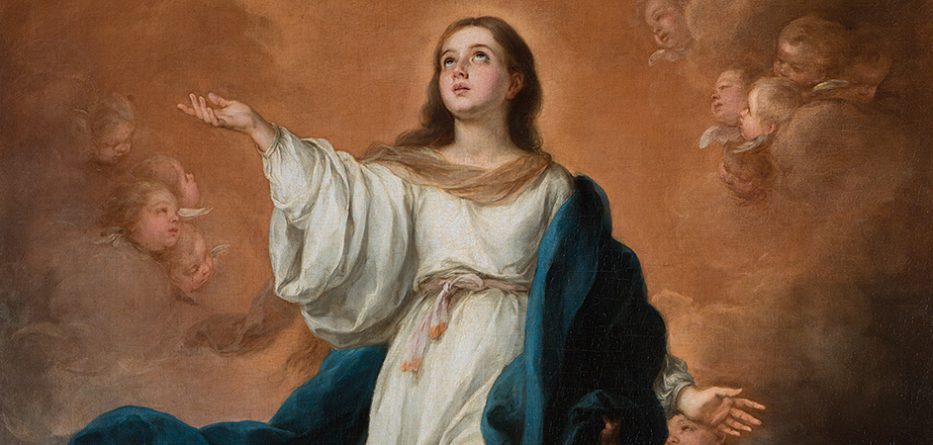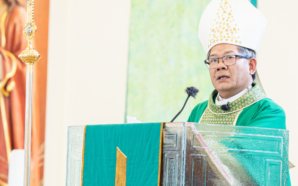Homily for the Solemnity of The Assumption of the Blessed Virgin Mary
15 August 2020
To be honest, I’ve never quite known what to say when it comes to preaching about the Immaculate Conception, the Virgin Birth, or today’s feast, the Assumption of Mary into heaven. Like most Catholics, I pray to Mary especially at those times when I am in need and when I feel a little overwhelmed by the deity, whether it be God as Father, Son or Holy Spirit, or God as Creator, Redeemer or Sustainer. After all, Mary is one of us. She was a young woman with freedom who, while subject to all the ordinary expectations and pressures, said the most faith-filled human ‘yes’ to God in history. And she stored everything in her heart, including the crucifixion of her son.
Part of my hesitation about Immaculate conception, virginity and assumption is that they seem to be attributes which distinguish her absolutely and definitively from any of us, rather than affirming that it was one just like us who said ‘yes’ at the Annunciation and carried all that she did. Over the years, I have found that almost all Catholics are pleased to have Mary at their side and on their lips when they are hospital-bound, especially when they are on their death bed. The feminist theologian Elizabeth A Johnson in her book She Who Is: The Mystery of God in Feminist Theological Discourse has pointed out that many Catholics tend to substitute Mary for the Holy Spirit: ‘this village woman, mother of Jesus, honoured as Mother of God, functions as an icon of the maternal God, revealing divine love as merciful, close, interested in the poor and the weak, ready to hear human needs, related to the earth, trustworthy and profoundly attractive.’ Those of a more Protestant bent are more likely to find this feminine aspect of God in the Holy Spirit.
LISTEN: https://soundcloud.com/frank-brennan-6/homilly-for-the-feast-of-the-assumption
Early in my Jesuit life, a new provincial changed my work plans. Instead of starting my work as a lawyer committed to Aboriginal rights, I was asked to spend a year teaching Year 10 Mathematics at Xavier College here in Melbourne. The highly irreverent Fr Geoffrey James SJ who was on the staff there and who knew that I was not immediately overjoyed by this change of plans wrote to me saying ‘Isn’t God clever?’ When the feast of the Assumption came around, he told the boys with a touch of mischief that this was the day when we assumed that Mary was in heaven. Geoff died young, and presumably now knows the answer. Presumably, we celebrate more than the assumption made by Geoff James. We celebrate the reality with faith and hope.
Back in 1950, Pope Pius XII published an apostolic constitution Munificentissimus Deus in which he declared: ‘that the Immaculate Mother of God, the ever Virgin Mary, having completed the course of her earthly life, was assumed body and soul into heavenly glory’. He made this definitive declaration after surveying the bishops of the Church. He asked the bishops if they judged that the Assumption of Mary ‘can be proposed and defined as a dogma of faith’ and whether they desired it. About half the bishops of the world responded to the survey. Only six of those who responded voiced any reservations.
In 1963, the bishops at the Second Vatican Council debated whether to publish a separate decree on Mary. In the end, they voted against a separate decree, deciding by 1,114 to 1,074 to include their deliberations on Mary as an extra chapter of Lumen Gentium, the Dogmatic Constitution on the Church. The Church Fathers declared that ‘preserved free from all guilt of original sin, the Immaculate Virgin was taken up body and soul into heavenly glory upon the completion of her earthly sojourn’.
Shortly after Pius XII’s declaration, the Jesuit theologian Karl Rahner turned his attention to an interpretation of this dogma. What do we mean when we say that Mary was assumed body and soul into heavenly glory? Rahner was upfront admitting that ‘it is usual for theologians today to reply to the question as to the “place” of heaven by merely saying that it is above all a “condition”’ and that ‘it is, in fact, impossible to say just “where” heaven is’.
Rahner’s starting point and centrepoint is always Jesus, not Mary. He tells us: ‘Christ’s body remains…eternally a piece of this world, bound up with it in its deepest and inmost ground; otherwise the mortal world would not have attained to eternal life or the unity of the world would be split asunder.’ He then considers Mary: ‘if Mary is the ideal representation of exhaustive redemption because of her unique place in saving history, then she must “even now” have achieved that perfect communion with God in the glorified totality of her real being (“body and soul”) which certainly exists even now.’ Rahner thought that those of a Protestant mindset would see this as ‘ultimately only a promise’ whereas those of a more Catholic mindset would see it as existing ‘“even now”, although it has not embraced everything yet and for us here below has not yet become apparent’. He concluded: ‘That this state of salvation should be attributed to Mary in its entirety and fullness will not seem an impossibility to someone who knows that this salvation was born of her in virtue of the consent of her faith and in consequence, has had its most perfect effect in her.’
Author and poet Peter Steele, who was scholar in residence here at Newman College for many years, in one of his last interviews for ABC Radio National said: ‘I’ve written about all sorts of things in my various writings, one of the great subjects has always been mortality, and it is a comfort to me that our mortality, as I firmly believe, is a condition…let’s call it a room, which is what John Donne called it, which precedes and leads into a capacious and entirely blessed and secure immortality, one of whose names is heaven. And I believe in that very, very strongly. And I probably believe that more strongly than almost anything else.’
On this feast of the Assumption, we celebrate Mary’s ‘capacious and entirely blessed and secure immortality’ here and now. We Catholics who have trouble understanding or sympathising with the formal declaration of the doctrine can draw some consolation from St John Henry Newman, the patron of our college.
As an Anglican, Newman always had ‘a true devotion to the Blessed Virgin’. He was, of course, the vicar of the University Church of St Mary the Virgin at Oxford. In his tracts on Romanism prior to his conversion, he was ‘strongly pointing out the impossible barriers which lie between us and Rome’ and he gave as an example, ‘the worship of the Virgin’.[1] As a Catholic, he gave a series of meditations on the Assumption. Just as Pius XII was to do a century later, he conceded that there was no direct scriptural warrant for Mary’s Assumption. But he pointed to Matthew 27:52-3 in which the gospel writer declares that at the moment of Jesus’ death, ‘the tombs opened and the bodies of many holy people rose from the dead, and these, after his resurrection, came out of the tombs, entered the Holy City and appeared to a number of people’. If there were to be some enjoying an earlier resurrection than the rest of us, then surely Mary would have joined them immediately on her death. Newman asked, ‘Can we suppose that Abraham, or David, or Isaiah, or Ezechias, should have been thus favoured, and not God’s own mother? Had she not a claim on the love of her Son to have what any others had? Was she not nearer to Him than the greatest of the Saints before her?’
The early Christians went to extraordinary lengths to treasure the mortal remains, belongings and locations of the first saints – these lengths sometimes included devotions and claims which had no basis in fact. There is no evidence of such practices in relation to Mary. Newman asked, ‘If her body was not taken into heaven, where is it? How comes it that it is hidden from us? Why do we not hear of her tomb as being here or there? Why are not pilgrimages made to it? Why are not relics producible of her, as of the saints in general?’ What chance would St Peter’s in Rome have had if there were St Mary’s somewhere over the purported tomb of Jesus’ mother! In a letter to Robert Charles Jenkins on 11 January 1879, Newman wrote, ‘I do believe it, tho’ the Church has not defined it…It is to me impossible to hold what we hold about Mary, as the second Eve, and the Mother of God, and yet deny her Assumption, though we have no direct proof of it.’ Not even Pius XII could produce that scriptural proof 71 years later.
With the Church having defined the doctrine, another cardinal of our Church who was a convert, Avery Dulles SJ, invested considerable effort in dialogue with the Lutherans trying to reach agreement on what we might say about Mary. After seven years, the US theologians from both Churches could not reach agreement. But in the course of the dialogue, Dulles described Pius XII’s method of defining the doctrine as ‘regressive’ in that he gave pride of place to the prevailing view of the present-day bishops and the faithful and only then sought ‘to garner support in Scripture and tradition’. Dulles asserted that the definition proceeded ‘backward from the present situation of Mary in glory rather than forward from her earthly history, thus avoiding many of the problems raised by the lack of reliable historical testimonies, and by conflicting theological speculations, about the death and entombment of Mary.’ In their final statement, the US Catholic and Lutheran theologians suggested that ‘our two churches would make greater progress toward fellowship by taking two further steps within the framework of common study and dialogue.’
One step would be a Lutheran acknowledgment ‘that the Catholic teaching about … Mary as set forth in …Vatican II does not promote idolatrous belief or practice and is not opposed to the gospel.’ Another would be acknowledgment by the Catholic Church ‘that in a closer but still incomplete fellowship, Lutherans, focusing on Christ the one Mediator, as set forth in Scripture, would not be obliged’ to affirm Mary’s assumption.
Celebrating the mystery of Mary’s Assumption today without quite knowing what it means or what it is, we give thanks for the access we have and the empathy we experience from Mary who is with her Son Jesus enjoying capacious and entirely blessed and secure immortality. Praying ‘Hail Mary, full of grace’, we celebrate and affirm the female aspect of our loving God. In her last book Consider Jesus: Waves of Renewal in Christology, Elizabeth A Johnson takes a justified pot shot at even the most sophisticated theologians who fall into the trap of saying, ‘God is not male, He is spirit.’ She asks, ‘Why does it always have to be “he”? It is because we are operating within an androcentric framework, supported by the maleness of Jesus, which presumes that God always has to be considered male.’
Johnson warns us, ‘The gender of Jesus has been taken to be the mode or paradigm of what it means to be human. This is interpreted literally to mean that maleness is closer to the human ideal than is femaleness.’ She says, ‘Proof of this attitude is seen in reactions to a hypothetical question about the incarnation. The Word became flesh: God who is beyond gender became a human being. Could God have become a human being as a woman?’
Yes, God could. But as it turns out, Jesus was a man. His mother Mary, a woman, enjoys capacious and entirely blessed and secure immortality with her Son here and now, body and soul. That’s what we celebrate today. Happy Feast Day. Holy Mary, Mother of God, pray for us sinners, now and at the hour of our death. Amen.
[1] Letter to Hugh James Rose, 23 May 1836
Fr Frank Brennan SJ is the Rector of Newman College, Melbourne and the former CEO of Catholic Social Services Australia (CSSA).








